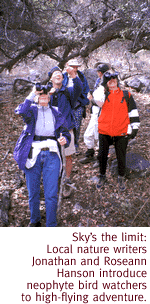
What Better Way To Learn About Your Environment Than To Study The Critters Who Live There?
By Kevin Franklin
LIKE TOO MANY other outdoor enthusiasts, I'm bird illiterate.
Fortunately there are groups like the Tucson Audubon Society that
will take the ignorant masses under their collective wing.
So when Roseann and Jonathan Hanson invited me along for a two-day
Audubon Society birding workshop, I jumped at the chance.
 This informal instruction takes place at the Brown Canyon Environmental
Education Center. Brown Canyon sits at the foot of Baboquivari
Peak in the Buenos Aires National Wildlife Refuge, just south
of Three Points.
This informal instruction takes place at the Brown Canyon Environmental
Education Center. Brown Canyon sits at the foot of Baboquivari
Peak in the Buenos Aires National Wildlife Refuge, just south
of Three Points.
Both of the Hansons hold degrees in ecology and work as natural
history writers. For more than two years, they lived in Brown
Canyon, working as caretakers and ecological interpreters. So
they're ideally suited to teach these classes.
This is an intermediate class, but the Hansons also coordinate
beginning and advanced classes through the Tucson Audubon Society.
In the beginning classes, the Hansons teach people how to identify
general bird types and how to use field guides and binoculars.
In the intermediate class, they discuss how to identify birds
by sound, behavior and habitat. The idea is to be able identify
birds without seeing them, or with just a glance. One of the central
elements to identifying birds in the field and on the wing is
"giz," says Jonathan.
Giz refers to the general impression you get from a bird as it
disappears into the bush or over the hill. It's knowing a bird
without exactly pinpointing the precise identifying elements.
It's much the same way you recognize a friend from a distance
without seeing the details of her face, Jonathan says.
There are certain markers that you notice, maybe even subconsciously.
It might be a general shape or a flash of an unusual color. By
knowing the ecology of the different birds, you already have some
notion of what you're likely to find in a certain habitat or time
of year. Piecing that together with a sound, silhouette or fleeting
glimpse can often let you identify a bird.
Where the term "giz" came from, no one is exactly sure,
Jonathan says. It might be an abbreviation for gist, or it might
allude to Gestalt, or maybe some long-ago birder just made it
up. But learning good giz is at the heart of every birding class.
Many folks might scoff at the notion of wandering around the
forest with binoculars and book in hand, and continually looking
up at the sky and tree canopy like tourists in a skyscraper city.
But learning a new field of natural history is like learning to
speak the language of the creatures surrounding you. Once you've
recognized a bird by name, you can learn about its ecology: where
it lives, what it eats and if it's common or rare. Then the next
time you're hiking in the woods and see a bird you know, you begin
to understand more about what's going on around you.
 It's like learning the names of your neighbors, Roseann says.
Once you do so, they cease to be strangers. This is the foundation
for a neighborhood, and possibly a friendship.
It's like learning the names of your neighbors, Roseann says.
Once you do so, they cease to be strangers. This is the foundation
for a neighborhood, and possibly a friendship.
"Learning the names of things helps us understand them and
ultimately want to protect them," she says.
Besides, it makes outings all the more fun. It's one more element
to look for and enjoy; and some birds are truly thrilling to see.
"We used to make fun of people running around the forest
with binoculars and searching for birds," says Stan Penny
during the hike up Brown Canyon. "Then we took a quiet and
reserved friend of ours on a hike and she saw her first vermilion
flycatcher. Watching it hover through a pair of binoculars, this
demure little woman shouted out, 'Holy shit!' All of a sudden
we realized there was something more here than we ever knew existed.
That's how we got started--someone else's excitement just bubbled
over."
"That's why we do it," Roseann says. "Seeing someone
get excited about birds is a lot of fun. We really get a kick
out of introducing people to all sorts of things, from birding
to plant identification."
Getting There
The Tucson Audubon Society will run a flock of birding
classes this spring, including: Intermediate Birding, January
11; Beginning Birding, February 7-8; Advanced Birding, February
8; and Intermediate Birding again, March 28-29. Call 624-4745
for more information.

|





